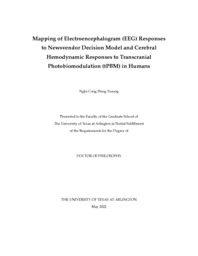| dc.description.abstract | Decision-making is one of the most critical activities of human beings. Various studies have investigated the brain responses to a variety of decision tasks by deploying the EEG data. The first aim of my dissertation was to investigate the neurocognitive mechanisms and correlations across multiple subjects when people make risky economic decisions. A decision-making task was designed based on the newsvendor problem (NP) with two scenarios: low-profit margins (LM) as the more challenging scenario and high-profit margins (HM) as the less difficult one. The EEG signals were acquired from healthy humans while subjects were performing the task. The Correlated Component Analysis (CorrCA) method was adopted to identify linear combinations of EEG channels that maximize the correlation across subjects or trials. The inter-subject or inter-trial correlation values (ISC or ITC) of the first three components were estimated to investigate the modulation of the task difficulty on subjects’ EEG signals and respective correlations. The alpha- and beta-band power of the projection components obtained by the CorrCA was also calculated to assess the brain responses across multiple task periods. Finally, the CorrCA forward models, which represent the scalp projections of the brain activities by the maximally correlated components, were further translated into source distributions of underlying cortical activity using the exact Low Resolution Electromagnetic Tomography Algorithm (eLORETA). In Chapter 2, I reported strong and significant correlations in EEG signals among multiple subjects and trials during the more difficult decision-making task than the easier one. Experimental results also disclosed that the NP decision-making and feedback tasks desynchronized the normalized alpha and beta powers of the CorrCA components, reflecting the engagement state of subjects. Source localization results also suggested several sources of neural activities during the NP decision-making process, including the dorsolateral prefrontal cortex (DLPFC), anterior PFC (aPFC), orbitofrontal cortex (OFC), posterior cingulate cortex (PCC), and somatosensory association cortex (SAC).
My second aim focused on the mechanistic understanding of transcranial photobiomodulation (tPBM) effects. Over the past decade, tPBM has been considered a safe and effective brain stimulation modality being able to enhance cerebral oxygenation and neurocognitive function. To better understand the underlying neurophysiological effects of tPBM in the human brain, a 111-channel functional near-infrared spectroscopy (fNIRS) system was utilized to map cerebral hemodynamic responses over the whole head to 8-min tPBM with 1064-nm laser given on the forehead of 19 healthy participants. Instead of analyzing broad-frequency hemodynamic signals (0-0.2 Hz), frequency-specific effects of tPBM on three infra-slow oscillation (ISO) components consisting of endogenic, neurogenic, and myogenic vasomotions were investigated. Chapter 3 reported significant changes induced by tPBM in spectral power of oxygenated hemoglobin concentration (Δ[HbO]), functional connectivity (FC), and global network metrics at each of the three ISO frequency bands for three ISO frequency bands. Experimental results revealed that tPBM significantly increased endogenic Δ[HbO] powers over the right frontopolar area near the stimulation site. Also, tPBM enabled significant enhancements of endogenic and myogenic FC across cortical regions as well as of several global network metrics.
My third aim sought to derive a theoretical analysis to quantify how the signal-to-noise ratio (SNR) of the near-infrared spectroscopy (NIRS) device influences the accuracy of calculated changes of oxy-hemoglobin (Δ[HbO]), deoxy-hemoglobin (Δ[HHb]), and oxidized cytochrome c oxidase (Δ[oxCCO]). In theory, all NIRS experimental measurements include variations due to thermal or electrical noise, drifts, and disturbance of the device. I applied the error propagation analysis to compute the variability or variance of Δ[HbO], Δ[HHb], and Δ[oxCCO] depending on the system SNR. The quantitative expressions of variance or standard deviations of changes in chromophore concentrations were derived based on the error propagation analysis and the modified Beer-Lambert law. In order to compare and confirm the derived variances versus those from the actual measurements, two datasets of broadband NIRS (bbNIRS) measurements using a solid tissue phantom and the human forearm were collected. A Monte Carlo framework was also executed to simulate the bbNIRS data under two physiological conditions for further confirmation of the theoretical analysis. Finally, the confirmed expression for error propagation was utilized for quantitative analyses to guide optimal selections of wavelength ranges and different wavelength combinations for minimal variances of Δ[HbO], Δ[HHb], and Δ[oxCCO] in actual experiments. | |


